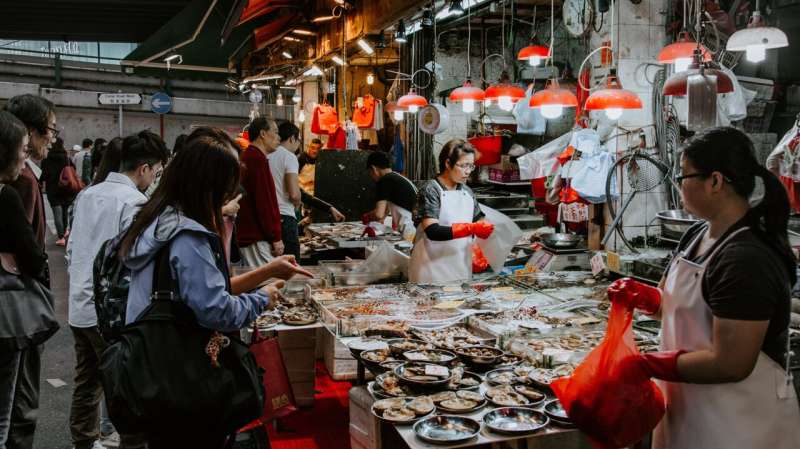Reframing the controversial bushmeat trade: Who determines which foods are appropriate for consumption?

As debates have raged on throughout the COVID-19 pandemic—from lockdowns, to mask mandates, to vaccinations—experts have sought to pinpoint the origins of the virus. Most research has centered on Wuhan, China, where the first cases of COVID-19 were diagnosed. Evidence suggests the virus passed from animals to humans at the Huanan Seafood Wholesale Market, a live animal and seafood market that is home to commonly eaten seafood and livestock—but also exotic animals and protected species from around the world.
Wuhan's "wet market" opened the world's eyes to the consumption of "bushmeat," defined as the meat of wild animals killed for food in developing countries. The continued consumption and trade of bushmeat stands to create an untenable risk to global public health and the health of critical ecosystems, but Yale researchers are taking a closer look to understand the role of bushmeat across global communities to create a more balanced narrative.
The ideas were recently published in Environmental Research Letters by authors Wen Zhou and Al Lim, combined doctoral students at YSE and the Yale Department of Anthropology; YSE Ph.D. student Kaggie Orrick; and Michael R. Dove, the Margaret K. Musser Professor of Social Ecology at YSE. The paper, "Reframing conservation and development perspectives onbushmeat," examines the normative values that underlie conservation and development interventions in what is considered the "bushmeat crisis."
The authors focused on three parameters that frame depictions of crisis: Global consequences versus local actions; the food practices and preferences of the developed world versus those of the developing; and rural hunters versus urban consumers. In the case of local vs. global, the values of conservationists and policymakers are taken into primary account, while local populations—indeed, more often economically insecure—are forced to make drastic changes.
"What we see is a strong emphasis on changing local practices in an attempt to prioritize global outcomes," says Zhou, the lead author. "But that puts undue stress on local peoples, who have long depended on bushmeat for both food and income. They are the ones being forced to change their culture."
This is not the only place the authors found a disconnect. Despite the inclusiveness of the phrase "global health," they say, serious zoonotic diseases have ravaged the global South but have often gone unaddressed by the global community.
When considering both the developed world and the developing world, the authors cautioned against the application of Western economic and industrial definitions of progress while denigrating local cultural and social norms. For example: Who determines which foods are appropriate for consumption and which modes of food production are acceptable?
"Culture is important here," says Lim. "What may seem unsavory to you and I may not to people who are used to eating it. So, to them, how is bushmeat really that backwards and destructive?"
Dove cites the "butterfly effect" theory to explain the connection between rural hunters and urban consumers—how easily an animal can be captured or killed in Southeast Asia and end up in a market in China, touching off a global pandemic. "It's made possible by the shrinking world we live in and amplified by breakdowns in governance at national and international levels," he says.
But the animals don't end up in urban areas without demand. The rapid growth of urban areas has meant rural areas are seen as the source of healthy foods; meanwhile, modern infrastructure is changing rural-urban boundaries, extending the reach of urban consumers into tropical and subtropical forests, significantly changing the dynamics of the bushmeat trade.
"There are new radical connections we are seeing around the world," says Lim. "It's no longer adequate to accept the status quo—the conservation practices and interventions we use in developed nations. We need to question who is making these decisions, who gets to determine what is modern."
And, Zhou says, pandemics will still occur, even with stricter policies against bushmeat. "It's impossible to prevent pandemics, and it speaks to our hubris that we believe we can prevent them with all of our technology. The issue is political frailties and our inability to respond to outbreaks."
Global, prescriptive conservation policies and actions to curb the wildlife trade and promote animal husbandry may not reduce the risk of future pandemics or prevent biodiversity loss, the authors say, and may even have inverse effects. That is why, they say, the global supply and demand for bushmeat ultimately must be understood in light of the complexity of behavior driven by livelihood needs, cultural beliefs, and the distance between where food is sourced and where it is sold.
More information: Wen Zhou et al, Reframing conservation and development perspectives on bushmeat *, Environmental Research Letters (2021). DOI: 10.1088/1748-9326/ac3db1
Journal information: Environmental Research Letters
Provided by Yale University



















